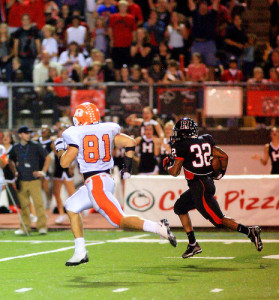
It’s halftime, the home team is down by ten, and they need an advantage—a way to exploit the opposing team’s weaknesses and win the game. In the locker room, coaches are analyzing video clips of the opposing team’s defensive line to find ways to get the ground game into gear. The quarterback is reviewing patterns the defenders are having trouble covering in order to spot opportunities to advance the ball through the air. At the same time, the defensive team is watching footage of the final drive of the first half that put their opponents up by ten, looking for ways to shut them down in the second half. And other players are reviewing the playbook on their tablets.
All of this activity is taking place on computers, tablets, and smartphones, using technology that was not permitted for use during high school football games until 2013. Thanks to changes to NFHS Rule 1.6.1.2, teams are now allowed to use video, instant replay, and video playbooks on the sidelines and in the press box during games.
About the Rule
NFHS Rule 1.6.1.2 applies in most states. Check with your school’s athletic director to clarify the rules where your team plays. The rule does have its boundaries. For example, video and sideline instant replay is not used to review calls made by the referees. Further, coaches are only permitted to use a tablet in specific circumstances:
- When both the coach and the players are on the sideline,
- Between the sideline and a 9-yard mark, and
- During conferences inside the 9-yard marks
Player benefits
High school football teams are seeing tremendous benefits from the new rule. The use of video and instant replay during games and practices allows coaches and players to analyze plays and drills in real time, and respond instantly with strategy adjustments or additional training. Video also provides a digital playbook of your own team, as well as that of your opponent. And when the season ends, players and coaches have access to an impressive library of video that can help them spot areas that need improvement.
Today’s player
The change in Rule 1.6 allows these high school athletes to identify areas of weakness, implement changes and improvements almost immediately, and see results faster. Video is an effective way for athletes to see what the coaches see, and work to improve their techniques. Also, the instant gratification of seeing what went right, as well as what went wrong, serves as strong motivation for players.
Challenges
Though there are obvious benefits to this technology, it isn’t without a few challenges. There are limitations as to where the players can view videos, depending on breaks in the game and accessibility to tablets and smartphones, so knowing that is important. Additionally, there can be a learning curve in setting up a video replay system, and teaching coaches how to use it effectively takes time. However none of these challenges detract from the incredible benefits video replay offers any high school football program. We’ll add here, with obvious bias, that the Reveal Sideline Replay system is easy to set up, a cinch to use, doesn’t require Wi-Fi, and comes with our team’s hands-on support, when you need it and where you need it.
What difference has rule 1.6.1.2 made in your football program? Have you taken steps to integrate technology into your coaching strategy? Are you seeing your athletes respond positively? What about your coaching staff? We’d love to hear your thoughts on the benefits of technology as a coaching tool.
Photo Credit: Stephen Shooter via Compfight cc

